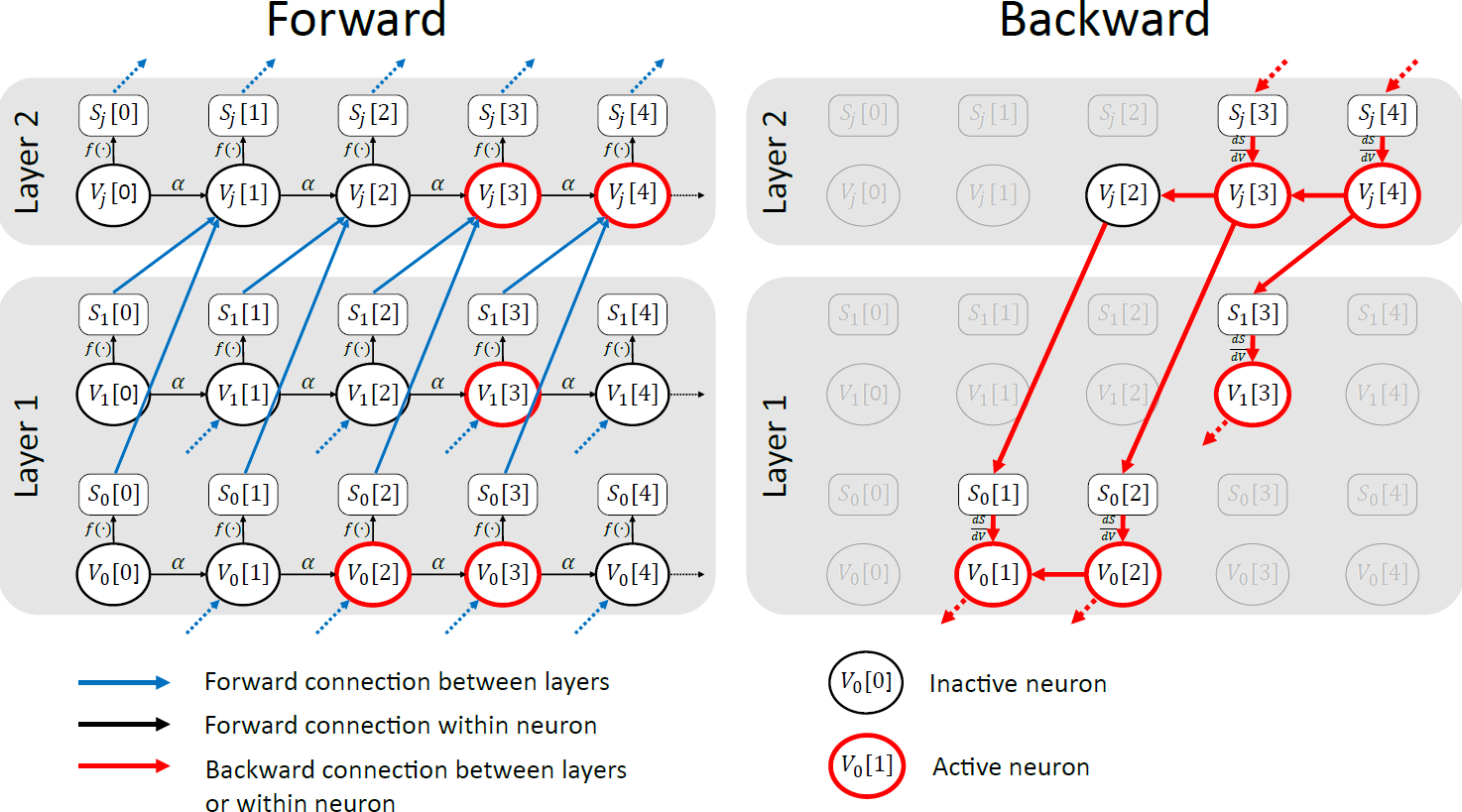Sparse Spiking Gradient Descent
A sparse gradient descent method for spiking neural networks that runs backpropagation up to 150x faster with up to 85% less memory. Link to article: https://proceedings.neurips.cc/paper/2021/hash/61f2585b0ebcf1f532c4d1ec9a7d51aa-Abstract.html
Citation:
@article{perez2021sparse,
title={Sparse Spiking Gradient Descent},
author={Perez-Nieves, Nicolas and Goodman, Dan FM},
journal={Advances in Neural Information Processing Systems},
year={2021} }
Requirements
Required:
- A CUDA capable GPU with CUDA 11.0 installed
- pyTorch 1.7.1
- GCC >=5 or equivalent C++ compiler
Optional:
- matplotlib (for plotting results)
- scipy (for plotting results)
- pytables (for reading .h5 files for SHD and N-MNIST datasets)
(We developed our code on pyTorch 1.7.1 and CUDA 11.0 but it should also work on other versions)
Detailed setup
We assumme you have a CUDA capable GPU with CUDA installed.
Create a new Anaconda environment and install the dependencies
conda env create -f environment.yml
Activate the environment
conda activate s3gd
Then install the torch extension.
cd cuda
python setup_s3gd_cuda.py install
This should install the extension. If everything went fine you should end up getting something similar to
...
Installed /home/USERNAME/.conda/envs/s3gd/lib/python3.8/site-packages/s3gd_cuda-0.0.0-py3.8-linux-x86_64.egg
Processing dependencies for s3gd-cuda==0.0.0
Finished processing dependencies for s3gd-cuda==0.0.0
You can test that the installation was successful by running the following
python
>>> import torch
>>> import s3gd_cuda
Running
You can now run the code
cd ..
python main.py
This will run with the Fashion-MNIST dataset by default.
If you wish to run the Spiking Heidelberg Digits (SHD) dataset you can download it.
Then save the train_shd.h5 and test_shd.h5 in datasets/SHD.
You can also download the Neuromorphic-MNIST dataset and convert the raw spikes into .h5 format.
After downloading Train.zip and Test.zip, unzip them and copy the directories to datasets/nmnist.
Then run
python datasets/nmnist/convert_nmnist2h5.py
Now you can specify the dataset that you wish to run
python main.py --dataset fmnist
python main.py --dataset nmnist
python main.py --dataset SHD
You can also find the code for the plots in the paper under the plotting direcctory.
We included the results for a single seed so that it can be run with either python final_plots.py for the main text plots or python supp_plots.py for the supplementary plots. Note that the SHD results in the provided data were obtained by using max-over-time on the readout layer instead of sum-over-time which is necessary to obtain the 75+% accuracy. The 75+% SHD data can be found in plotting/results_bth.
Results
Spiking neurons are inactive most of the time and yet the gradient is well approximated
- A. Percentage of active neurons during training as a fractionof total tensor size (BxTxN) with N=200 neurons for each dataset.
- B. Visualisation of weight and spike gradients on the SHD dataset. Zero values are shown in hatched grey. Note how the ∇W is nearly identical in both cases despite being computed using a small fraction of the values of ∇S in the sparse case.
- C. Loss evolution on the SHD dataset using both algorithms.
- D. Final test accuracyon all datasets using both methods
Sparse training is faster and less memory intensive
-
A. Backwardspeedup and memory saved in the second hidden layer for all three datasets when using sparsegradient descent with 200 hidden neurons.
-
B. Time spent in computing the backward pass in thesecond hidden layer consisting of 200 neurons when using regular gradient descent and sparsegradient descent.
-
C. Backward speed and memory saved in the second hidden layer as we increasethe number of hidden neurons in all hidden layers. We included the overall speedup which takes intoconsideration both the forward and backward times spent in the second layer.



